| Reviews & Columns |
|
Reviews DVD TV on DVD Blu-ray 4K UHD International DVDs In Theaters Reviews by Studio Video Games Features Collector Series DVDs Easter Egg Database Interviews DVD Talk Radio Feature Articles Columns Anime Talk DVD Savant Horror DVDs The M.O.D. Squad Art House HD Talk Silent DVD
|
DVD Talk Forum |
|
|
| Resources |
|
DVD Price Search Customer Service #'s RCE Info Links |
|
Columns
|
|
|
Requiem for a Dream -- Director's Cut
Lionsgate Home Entertainment // Unrated // September 8, 2009
List Price: $29.99 [Buy now and save at Amazon]
The Film:
Though Darren Aronofsky's Pi might be his freshman film, Requiem for a Dream clearly stands as the catapult for his career. That's not to turn a blind eye to his first work, which more than earns its Spirit Award for Best First Screenplay, but to show exactly how essential his sophomore film -- an adaptation of Hubert Selby's novel about drug addiction, also entitled "Requiem for a Dream" -- truly is. As a reflection on the corruption of innocence, it's nearly flawless; however, as a portrait of the dangers of addiction, Requiem for a Dream should not only be celebrated, but deemed a necessary viewing experience.
Structured by season running the course of a year (almost), the plot revolves around four individuals in the New York area dealing with addiction. Harry Goldfarb (Jared Leto) stands as the common link between all the individuals, with his girlfriend Marion (Jennifer Connelly), best friend Tyrone (Marlon Wayans), and mother Sara (Ellen Burstyn) each with their own types of dependence. The three twenty-somethings get wrapped up with heroin, both as users and dealers looking for a way out of their lives. Sara, on the other hand, endures the effects of a diet pill addiction as she prepares to go on television. They all have their own structured reasons, but it all comes back to one central desire: displacement from the real world.
At the start, Requiem for a Dream portrays the beauty of "flawed perfection" on an impeccable level. The romance between Harry and Marion isn't like a storybook painting, but the tangibility present in their tender connection carries a genuineness that'll appeal to anyone who's been in a true enduring relationship. Mirroring their conjoined enjoyment of life's little joys, Harry's mother Sara also indulges in simple pleasures -- television in her close-quartered apartment, the randomness of selecting chocolate from a box, little things -- all following the death of her husband that left her somewhat without purpose. Watching Harry and Tyrone wheel a television across long expanses of sun-baked New York boardwalks and streets shares a playful purity, even though we know exactly what they're going to do with it.
Aronofsky keeps a firm grasp on the chemistry that's been generated between all his impeccably-chosen actors, a mood that slowly mixes unsullied relationships with gradual splashes of corruption from outside sources. Watching these characters from a point of happiness makes witnessing their deconstruction utterly heartbreaking, yet powerful and touching enough to appeal to a broad range of deep emotional connections that we might have built with them. Like watching poison drop into a mixing bowl, we stand back and observe as chaste ingredients are slowly tainted by unwanted outside components. Each character holds their own strengths and weaknesses, from hopeful elements like Harry's charisma and Tyrone's ambition, to Marion's lack of ability to differentiate between acts of love and acts of counter-production towards the trio's illness. Jennifer Connelly's shift from innocence to darkness as Marion stands out as the second-most pronounced, as we can see it emptying from her disposition from start to finish.
Drawing a parallel between heroin use and Sara's doctor-prescribed diet pills marks the difference between Requiem for a Dream being in-reach with the audience and beyond comprehension to those inexperienced with addiction. Watching Harry's mother buzz around her apartment, popping pills in front of the television, and grow more and more emaciated in a similar fashion as her son reflects the same sort of caustic power behind harmful drug use. Ellen Burstyn's performance, in effect, ties everything together; though we watch the horrors of worst case scenarios with the younger users, it's with Sara's gradual fizzle towards chaos within the confines of her own home -- by means of a flippant doctor's prescription -- that the connection really hits home. Some of the comparisons achieved by Aronofsky between actual brick-and-mortar prison and the prison of Sara's sanity can be downright frightening.
The characters' situations may differ, but their addictions share one thing in common: a driving force to separate themselves from reality. They reveal internal demons to us -- most revolving around a desire to separate themselves from the banality of their substandard lives -- in a fashion that reflects an unappreciative eye for the simple joys in life. That implies that all of the joy we witness in the first part of Requiem for a Dream isn't powerful enough to keep them from plummeting into a world of swelling drug use. Or maybe, it's just that the insurmountable impact of drug dependency is so strong that it'll swallow even the most pure and pleasant of elements. Either way, it shows how quickly that grasp of reality can be lost and how life's little pleasures become invisible to jaded, hungry eyes.
Though heartbreaking to witness, Requiem for a Dream's cinematic style makes this painful deconstruction even more heartfelt and, in many ways, gorgeous to behold. It features a legendary score composed by Clint Mansell, revolving around the infamously haunting musical cue from his "Lux Aeterna" that catapulted his stature as a Hollywood composer. Though it's rare that a piece of music can so aptly reflect both the pinnacle of beauty and the darkest recesses of depression, Mansell's magnum opus score certainly achieves it. Since then, he's pieced together excellent scores for many works -- including a sublime score for Aronofsky's own The Fountain -- but the energy and breathtaking emotion present here is really something to behold.
Probably the most iconic element present in the film is the superb editing work from Jay Rabinowitz, Jim Jarmusch's long-time editor responsible for piecing together Ghost Dog: The Way of the Samurai and Dead Man, as he comes together with Aronofsky's vision and Matthew Libatique's cinematography to create something visually astounding. He's driven to task with Requiem for a Dream, combining lightning-fast quips to replicate the feverish process -- and time-consuming nature -- of doing drugs. Incorporating shots of widening and tightening retina, the stilted flow of blood cells through a vein, and the shifts between rapid and sluggish movement by adjustments in the flow between frames is a masterful achievement in pushing film as an artform dangerously close to the replication of real-life experiences. It envelops the audience within a dizzying yet undeniable tornado of beautiful chaos, one where we can barely watch the character's fall -- but can't manage to pull our eyes away in wonder.
To label Requiem for a Dream as merely a cautionary tale is drastically undercutting its potency. It's a potent character film with well-drawn, affective entities that we can't help but empathize with, even when they're spiraling down the darkest of paths. Aronofsky shows familiarity with the structure he's created, building a beautiful arc between splendor and limitless suffering that looks in both directions. The characters look back at a life before they got wrapped up in intravenous drugs, while we -- a broad range of humans with scoring levels of corruption -- look at their downward spiral as a deeply communicated warning. Yes, it's a cautionary tale; but Requiem for a Dream's ability to connect with its audience comes as close to visualizing the collapse of friends, family, even one's self, as you're likely to get.
I have no qualms in admitting that Requiem for a Dream succeeds in causing me to shed at least a tear or two upon every viewing. It draws audiences of many different styles to its message, appealing to those curious about the effects of drug use all the way to those who find the blanket of depression hard to remove from their lives. No matter the reason, Requiem for a Dream should become essential viewing to those approaching the age of lost innocence; Aronofsky's film reminds us to grasp a hold of the truly radiant elements in life, while attempting to dodge anything that might consume us. To speak to addiction, temptation, and diligence in trying to find a way out is a tough feat, but Requiem for a Dream -- with its poetic construction and potent allegorical resonance -- does it better than any film I've seen.
The Blu-ray:
Presented from Lionsgate in its Director's Cut concoction -- with a runtime at 1:41:25 -- Requiem for a Dream comes equipped in a standard Blu-ray case mirroring the coverart from the standard-definition release.
Video and Audio:
Requiem for a Dream mixes a wild array of different visual tricks with many different cameras, ranging from high-quality Arri-3 cams to Betacam footage for many of the tactics used in the film. It makes for a bizarre experience in high-definition, but Lionsgate's 1.85:1 AVC presentation steps up to the plate in making Aronofsky's film look the best that it likely can on Blu-ray. Many scenes showcase ample doses of depth, sharp detail, and dimensionality, like most of the close-ups on Jennifer Connelly (especially the frames with her against a grassy field) and the two-man shots with Marlon Wayans and Jared Leto. A healthy dose of film grain also coats most of the film, while the accepted shots featuring standard-definition footage of the television announcer look the way they should -- awful. Artistic intent leans on switching between clarity and different forms of distortion, which makes for a highly erratic Blu-ray experience.
But as a complete work of visual art, Requiem for a Dream holds a stable and impressive visual quality from start to finish. The stock footage of blood flowing mixes with crisp shots of eyeballs, all handled in precise fashion in both the split-screen and sequential fashion. Colors and flesh tones pop far more than the now-rusting Lionsgate / Artisan treatment, leaving the standard-definition presentation in the dust. Crisp blues, acidic greens, and the ever so blistering orange from Sara's hair sift through the mix of stale, colorless environments, all while preserving a strong cinematic appearance and very substantially replicated skin coloring. Even the distorted, cylindrical bottle-vision shots -- used to convey claustrophobic scenes -- are appropriately presented. Will Requiem for a Dream offer a sublime visual experience on Blu-ray? Not exactly, since the film wasn't made to be crisp and beautiful; but the way Lionsgate have presented Aronofsky's film will certainly impress with the way this Blu-ray presents a colorful and engrossing piece of semi-abstract filmmaking.
Lionsgate's DTS HD Master Audio track, on the other hand, leaves a little bit to be desired. Though Clint Mansell's score sounds absolutely outstanding as it floods all channels in graceful, ambient fashion, vocal clarity wasn't as clean as I'd like. Though most of the dialogue was consistently discernible, it's somewhat distant and clamped down in comparison to the rest of the audio elements. These issues were more prevalent in intimate scenes, especially the early conversation between Marion and Harry as they lay side to side. Other sequences, mind you, were fine in the verbal clarity department -- such as several of the couch conversations between Harry and Tyrone. Everything else, especially the broad range of maddening sound effects during the drug use scenes, popped with plenty of crispness. Though marred slightly by a lack of verbal clarity, it's clear that the audio track makes ample usage of all channels involved, reaching to the very rear on a handful of occasions for a quality, enveloping experience. Optional subtitles are available in English, English SDH, and Spanish, while the 7.1 Master Audio track is the only aural option.
Special Features:
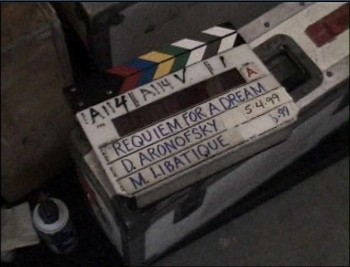 Commentaries w/ Darren Aronofsky, Matthew Libatique:
Commentaries w/ Darren Aronofsky, Matthew Libatique:
Both Darren Aronofsky and cinematographer Matthew Libatique offer tracks dissecting the picture, both of which were available on the previous DVD. Darren Aronofsky struggles to keep up with his own filmic pacing, but gets in the groove as time goes on. He discusses similarities in shooting the different kinds of drugs present in the film, his reflections on the New York subway, and how one of his actors gorged himself on steak -- by command of Aronofsky, of course. He also delves into how he hooked with Selby Jr. and his film school experience. Matthew Libatique's commentary latches on to task, discussing visual element after visual element that he utilized in his shooting -- the color red, framing certain shots to convey tension and happiness, etc.
The Making of Requiem for a Dream (35:19, MPEG-2):
Also carried over from the previous DVD is the stream of raw footage shot behind-the-scenes for Requiem for a Dream. You'll get a behind-the-scenes look at Ellen Burstyn's 45-minute stumble around the apartment set to achieve roughly 20 seconds of footage, some close-quartered shots that analyze the "fork stabbing" scene, as well as a few shots of the Kronos Quartet performing the film's signature song with sound mixers close by. Darren Aronofsky offers patches of commentary on the footage, which is mostly left raw and unedited.
Also available are the Memories, Dreams, and Addictions (19:56, SD MPEG-2) piece where Ellen Burstyn interviews "Requiem for a Dream" author Hubert Selby Jr, a set of nine Deleted Scenes (SD MPEG-2) with optional commentary from Darren Aronofsky, as well as a Teaser Trailer (MPEG-2), Theatrical Trailer (MPEG-2) and two short TV Spots (SD MPEG-2). Missing from the mix is the Anatomy of a Scene piece, which is a shame since it's a compact yet potent little interview with Aronofsky where he discusses getting sound effects and mirroring storyboards with images for the film. The text-based Production Notes have also been nixed.
Final Thoughts:
Requiem for a Dream is a gut-wrenching masterwork for growingly-acclaimed director Darren Aronofsky. Though it's utterly crucial cinema that should be watchedas both a powerhouse film and as a heed of caution to everyone, it's extremely difficult to sit through more than once. However painful it may be to witness, it grows more personal and deeply-felt with each screening -- and with this being a fourth screening of this film for this reivewer, it still hasn't lost an ounce of potency. Lionsgate's Blu-ray offers a striking visual presentation of the content, suitable audio, and a nice string of supplements carried over from the previous standard-definition release. Though replay value is questionable for most, it's certainly well worth the money to have an ample, wonderfully cinematic presentation of Requiem for a Dream on hand for anyone who hasn't had the experience in watching this film. Highly Recommended.
Thomas Spurlin, Staff Reviewer -- DVDTalk Reviews | Personal Blog/Site
 |
| |
Structured by season running the course of a year (almost), the plot revolves around four individuals in the New York area dealing with addiction. Harry Goldfarb (Jared Leto) stands as the common link between all the individuals, with his girlfriend Marion (Jennifer Connelly), best friend Tyrone (Marlon Wayans), and mother Sara (Ellen Burstyn) each with their own types of dependence. The three twenty-somethings get wrapped up with heroin, both as users and dealers looking for a way out of their lives. Sara, on the other hand, endures the effects of a diet pill addiction as she prepares to go on television. They all have their own structured reasons, but it all comes back to one central desire: displacement from the real world.
At the start, Requiem for a Dream portrays the beauty of "flawed perfection" on an impeccable level. The romance between Harry and Marion isn't like a storybook painting, but the tangibility present in their tender connection carries a genuineness that'll appeal to anyone who's been in a true enduring relationship. Mirroring their conjoined enjoyment of life's little joys, Harry's mother Sara also indulges in simple pleasures -- television in her close-quartered apartment, the randomness of selecting chocolate from a box, little things -- all following the death of her husband that left her somewhat without purpose. Watching Harry and Tyrone wheel a television across long expanses of sun-baked New York boardwalks and streets shares a playful purity, even though we know exactly what they're going to do with it.
Aronofsky keeps a firm grasp on the chemistry that's been generated between all his impeccably-chosen actors, a mood that slowly mixes unsullied relationships with gradual splashes of corruption from outside sources. Watching these characters from a point of happiness makes witnessing their deconstruction utterly heartbreaking, yet powerful and touching enough to appeal to a broad range of deep emotional connections that we might have built with them. Like watching poison drop into a mixing bowl, we stand back and observe as chaste ingredients are slowly tainted by unwanted outside components. Each character holds their own strengths and weaknesses, from hopeful elements like Harry's charisma and Tyrone's ambition, to Marion's lack of ability to differentiate between acts of love and acts of counter-production towards the trio's illness. Jennifer Connelly's shift from innocence to darkness as Marion stands out as the second-most pronounced, as we can see it emptying from her disposition from start to finish.
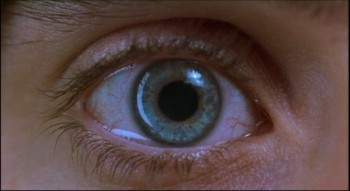 | 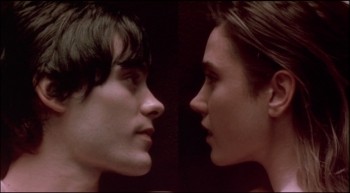 |
Drawing a parallel between heroin use and Sara's doctor-prescribed diet pills marks the difference between Requiem for a Dream being in-reach with the audience and beyond comprehension to those inexperienced with addiction. Watching Harry's mother buzz around her apartment, popping pills in front of the television, and grow more and more emaciated in a similar fashion as her son reflects the same sort of caustic power behind harmful drug use. Ellen Burstyn's performance, in effect, ties everything together; though we watch the horrors of worst case scenarios with the younger users, it's with Sara's gradual fizzle towards chaos within the confines of her own home -- by means of a flippant doctor's prescription -- that the connection really hits home. Some of the comparisons achieved by Aronofsky between actual brick-and-mortar prison and the prison of Sara's sanity can be downright frightening.
The characters' situations may differ, but their addictions share one thing in common: a driving force to separate themselves from reality. They reveal internal demons to us -- most revolving around a desire to separate themselves from the banality of their substandard lives -- in a fashion that reflects an unappreciative eye for the simple joys in life. That implies that all of the joy we witness in the first part of Requiem for a Dream isn't powerful enough to keep them from plummeting into a world of swelling drug use. Or maybe, it's just that the insurmountable impact of drug dependency is so strong that it'll swallow even the most pure and pleasant of elements. Either way, it shows how quickly that grasp of reality can be lost and how life's little pleasures become invisible to jaded, hungry eyes.
Though heartbreaking to witness, Requiem for a Dream's cinematic style makes this painful deconstruction even more heartfelt and, in many ways, gorgeous to behold. It features a legendary score composed by Clint Mansell, revolving around the infamously haunting musical cue from his "Lux Aeterna" that catapulted his stature as a Hollywood composer. Though it's rare that a piece of music can so aptly reflect both the pinnacle of beauty and the darkest recesses of depression, Mansell's magnum opus score certainly achieves it. Since then, he's pieced together excellent scores for many works -- including a sublime score for Aronofsky's own The Fountain -- but the energy and breathtaking emotion present here is really something to behold.
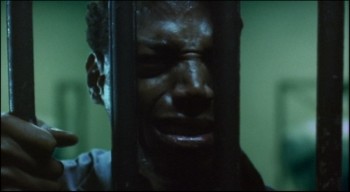 | 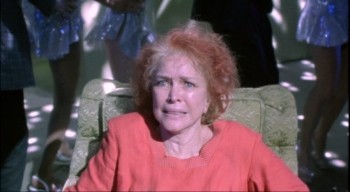 |
Probably the most iconic element present in the film is the superb editing work from Jay Rabinowitz, Jim Jarmusch's long-time editor responsible for piecing together Ghost Dog: The Way of the Samurai and Dead Man, as he comes together with Aronofsky's vision and Matthew Libatique's cinematography to create something visually astounding. He's driven to task with Requiem for a Dream, combining lightning-fast quips to replicate the feverish process -- and time-consuming nature -- of doing drugs. Incorporating shots of widening and tightening retina, the stilted flow of blood cells through a vein, and the shifts between rapid and sluggish movement by adjustments in the flow between frames is a masterful achievement in pushing film as an artform dangerously close to the replication of real-life experiences. It envelops the audience within a dizzying yet undeniable tornado of beautiful chaos, one where we can barely watch the character's fall -- but can't manage to pull our eyes away in wonder.
To label Requiem for a Dream as merely a cautionary tale is drastically undercutting its potency. It's a potent character film with well-drawn, affective entities that we can't help but empathize with, even when they're spiraling down the darkest of paths. Aronofsky shows familiarity with the structure he's created, building a beautiful arc between splendor and limitless suffering that looks in both directions. The characters look back at a life before they got wrapped up in intravenous drugs, while we -- a broad range of humans with scoring levels of corruption -- look at their downward spiral as a deeply communicated warning. Yes, it's a cautionary tale; but Requiem for a Dream's ability to connect with its audience comes as close to visualizing the collapse of friends, family, even one's self, as you're likely to get.
I have no qualms in admitting that Requiem for a Dream succeeds in causing me to shed at least a tear or two upon every viewing. It draws audiences of many different styles to its message, appealing to those curious about the effects of drug use all the way to those who find the blanket of depression hard to remove from their lives. No matter the reason, Requiem for a Dream should become essential viewing to those approaching the age of lost innocence; Aronofsky's film reminds us to grasp a hold of the truly radiant elements in life, while attempting to dodge anything that might consume us. To speak to addiction, temptation, and diligence in trying to find a way out is a tough feat, but Requiem for a Dream -- with its poetic construction and potent allegorical resonance -- does it better than any film I've seen.
The Blu-ray:
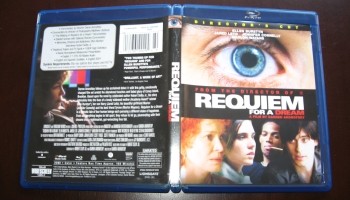 |  |
Presented from Lionsgate in its Director's Cut concoction -- with a runtime at 1:41:25 -- Requiem for a Dream comes equipped in a standard Blu-ray case mirroring the coverart from the standard-definition release.
Video and Audio:
Requiem for a Dream mixes a wild array of different visual tricks with many different cameras, ranging from high-quality Arri-3 cams to Betacam footage for many of the tactics used in the film. It makes for a bizarre experience in high-definition, but Lionsgate's 1.85:1 AVC presentation steps up to the plate in making Aronofsky's film look the best that it likely can on Blu-ray. Many scenes showcase ample doses of depth, sharp detail, and dimensionality, like most of the close-ups on Jennifer Connelly (especially the frames with her against a grassy field) and the two-man shots with Marlon Wayans and Jared Leto. A healthy dose of film grain also coats most of the film, while the accepted shots featuring standard-definition footage of the television announcer look the way they should -- awful. Artistic intent leans on switching between clarity and different forms of distortion, which makes for a highly erratic Blu-ray experience.
But as a complete work of visual art, Requiem for a Dream holds a stable and impressive visual quality from start to finish. The stock footage of blood flowing mixes with crisp shots of eyeballs, all handled in precise fashion in both the split-screen and sequential fashion. Colors and flesh tones pop far more than the now-rusting Lionsgate / Artisan treatment, leaving the standard-definition presentation in the dust. Crisp blues, acidic greens, and the ever so blistering orange from Sara's hair sift through the mix of stale, colorless environments, all while preserving a strong cinematic appearance and very substantially replicated skin coloring. Even the distorted, cylindrical bottle-vision shots -- used to convey claustrophobic scenes -- are appropriately presented. Will Requiem for a Dream offer a sublime visual experience on Blu-ray? Not exactly, since the film wasn't made to be crisp and beautiful; but the way Lionsgate have presented Aronofsky's film will certainly impress with the way this Blu-ray presents a colorful and engrossing piece of semi-abstract filmmaking.
Lionsgate's DTS HD Master Audio track, on the other hand, leaves a little bit to be desired. Though Clint Mansell's score sounds absolutely outstanding as it floods all channels in graceful, ambient fashion, vocal clarity wasn't as clean as I'd like. Though most of the dialogue was consistently discernible, it's somewhat distant and clamped down in comparison to the rest of the audio elements. These issues were more prevalent in intimate scenes, especially the early conversation between Marion and Harry as they lay side to side. Other sequences, mind you, were fine in the verbal clarity department -- such as several of the couch conversations between Harry and Tyrone. Everything else, especially the broad range of maddening sound effects during the drug use scenes, popped with plenty of crispness. Though marred slightly by a lack of verbal clarity, it's clear that the audio track makes ample usage of all channels involved, reaching to the very rear on a handful of occasions for a quality, enveloping experience. Optional subtitles are available in English, English SDH, and Spanish, while the 7.1 Master Audio track is the only aural option.
Special Features:
 Commentaries w/ Darren Aronofsky, Matthew Libatique:
Commentaries w/ Darren Aronofsky, Matthew Libatique: Both Darren Aronofsky and cinematographer Matthew Libatique offer tracks dissecting the picture, both of which were available on the previous DVD. Darren Aronofsky struggles to keep up with his own filmic pacing, but gets in the groove as time goes on. He discusses similarities in shooting the different kinds of drugs present in the film, his reflections on the New York subway, and how one of his actors gorged himself on steak -- by command of Aronofsky, of course. He also delves into how he hooked with Selby Jr. and his film school experience. Matthew Libatique's commentary latches on to task, discussing visual element after visual element that he utilized in his shooting -- the color red, framing certain shots to convey tension and happiness, etc.
The Making of Requiem for a Dream (35:19, MPEG-2):
Also carried over from the previous DVD is the stream of raw footage shot behind-the-scenes for Requiem for a Dream. You'll get a behind-the-scenes look at Ellen Burstyn's 45-minute stumble around the apartment set to achieve roughly 20 seconds of footage, some close-quartered shots that analyze the "fork stabbing" scene, as well as a few shots of the Kronos Quartet performing the film's signature song with sound mixers close by. Darren Aronofsky offers patches of commentary on the footage, which is mostly left raw and unedited.
Also available are the Memories, Dreams, and Addictions (19:56, SD MPEG-2) piece where Ellen Burstyn interviews "Requiem for a Dream" author Hubert Selby Jr, a set of nine Deleted Scenes (SD MPEG-2) with optional commentary from Darren Aronofsky, as well as a Teaser Trailer (MPEG-2), Theatrical Trailer (MPEG-2) and two short TV Spots (SD MPEG-2). Missing from the mix is the Anatomy of a Scene piece, which is a shame since it's a compact yet potent little interview with Aronofsky where he discusses getting sound effects and mirroring storyboards with images for the film. The text-based Production Notes have also been nixed.
Final Thoughts:
Requiem for a Dream is a gut-wrenching masterwork for growingly-acclaimed director Darren Aronofsky. Though it's utterly crucial cinema that should be watchedas both a powerhouse film and as a heed of caution to everyone, it's extremely difficult to sit through more than once. However painful it may be to witness, it grows more personal and deeply-felt with each screening -- and with this being a fourth screening of this film for this reivewer, it still hasn't lost an ounce of potency. Lionsgate's Blu-ray offers a striking visual presentation of the content, suitable audio, and a nice string of supplements carried over from the previous standard-definition release. Though replay value is questionable for most, it's certainly well worth the money to have an ample, wonderfully cinematic presentation of Requiem for a Dream on hand for anyone who hasn't had the experience in watching this film. Highly Recommended.
|
| Popular Reviews |
| Sponsored Links |
|
|
| Sponsored Links |
|
|
| Release List | Reviews | Shop | Newsletter | Forum | DVD Giveaways | Blu-Ray | Advertise |
|
Copyright 2024 DVDTalk.com All Rights Reserved. Legal Info, Privacy Policy, Terms of Use,
Manage Preferences,
Your Privacy Choices | |||||||













